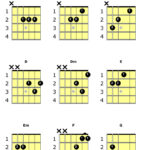A Bowed Guitar neck, often referred to as having too much “relief,” is a common issue that can significantly impact playability and intonation. While a slight bow in the neck is intentional and necessary for optimal string vibration, excessive bowing can lead to high action, buzzing strings, and an instrument that’s generally uncomfortable to play. Fortunately, there are several methods to address a bowed guitar neck, ranging from simple adjustments to more involved repair techniques. This guide explores these methods, providing a comprehensive overview for guitar players seeking to restore their instrument’s neck to its optimal condition.
Addressing Minor Bows: Fret Leveling
For guitars with a relatively small bow in the neck, the least invasive approach is often to level the frets. This process involves carefully filing down the tops of the frets to create a level plane. By ensuring all frets are at an even height, you can often compensate for a minor bow without needing to adjust the neck itself.
However, it’s crucial to understand the limitations of fret leveling. If the bow is significant, simply leveling the frets won’t be sufficient. In such cases, you’ll need to consider addressing the neck itself. Fret leveling is best suited for minor imperfections and can be a good first step in assessing the extent of the problem.
Leveling the Fingerboard: A Step Further
When fret leveling alone isn’t enough, the next logical step is to level the fingerboard itself. This involves removing the frets and then using specialized tools to carefully sand or plane the wood of the fingerboard to create a straighter surface. This method allows for a more substantial correction of the bow compared to just fret leveling.
Using tools like the Erlewine Neck Jig can be particularly helpful for this task. This jig supports the guitar neck in a controlled position, allowing for precise and even leveling of the fingerboard. It’s important to remember that the goal isn’t always to achieve a perfectly straight neck. A slight amount of relief is generally desirable for optimal playability.
Considerations for Fingerboard Leveling
Leveling the fingerboard requires caution. Removing too much wood can lead to problems, such as a fingerboard that becomes too thin, especially towards the higher frets. Additionally, after leveling, the fret slots may become shallower in certain areas and need to be deepened to accommodate the fret tangs properly. If your guitar has inlays on the fingerboard, these may also need to be removed and reinstalled or replaced during this process.
Corrective Refretting: Using Frets to Your Advantage
Another effective technique for correcting an up-bowed neck is corrective refretting. This method utilizes fret wire with tangs that are slightly wider than the fret slots. When these wider tangs are pressed into the narrower slots, they create compression that can help to pull the neck back against the bow.
This technique, sometimes referred to as a “corrective compression refret,” can be a powerful tool in straightening a bowed neck. For a deeper dive into this method, resources like articles on “corrective compression refret” techniques can provide valuable insights. Often, corrective refretting is used in conjunction with fingerboard leveling to achieve the desired neck straightness.
Addressing Extreme Bows: Neck Leveling
In more severe cases of bowing, it may be necessary to level the guitar neck itself, independent of the fingerboard. This is a more complex and invasive procedure that involves removing the fingerboard entirely and then working directly on the neck wood. After leveling the neck, the fingerboard is reattached, and further leveling may be performed on the fingerboard itself. Corrective refretting might also be incorporated as a final step.
Drawbacks and Benefits of Neck Leveling
Neck leveling is a more labor-intensive and costly repair option. Leveling the neck wood can subtly alter its shape, potentially requiring additional work to blend the fingerboard edges smoothly with the neck profile. Finish touch-ups are also often necessary after this type of work.
However, a significant advantage of neck leveling is the access it provides to the internal structure of the neck. This allows for the opportunity to reinforce the neck against future bowing. Options for reinforcement include installing a stronger truss rod (either adjustable or static) or adding carbon fiber beams to significantly increase neck stability.
Truss Rod Limitations: When Adjustment Isn’t Enough
It’s important to remember that even guitars equipped with adjustable truss rods can develop excessive bow that the truss rod alone cannot correct. Truss rods are designed to counteract string tension and make minor adjustments to neck relief. However, they have their limits.
While the repair methods discussed above are applicable even to guitars with truss rods, it’s always worth attempting to assist the truss rod before resorting to more drastic measures. Sometimes, simply relieving string tension and methodically working the truss rod can help bring the neck back towards a straighter position over time. However, if the bow is too severe or the truss rod is maxed out, the leveling and refretting techniques become essential for restoring optimal neck geometry and playability.
Conclusion: Restoring Playability
Addressing a bowed guitar neck requires a careful assessment of the severity of the bow and a methodical approach to repair. From minor fret leveling to more extensive neck leveling and reinforcement, various techniques are available to restore playability. Understanding these methods empowers guitar players to make informed decisions about maintaining their instruments and ensuring they remain enjoyable to play for years to come.

